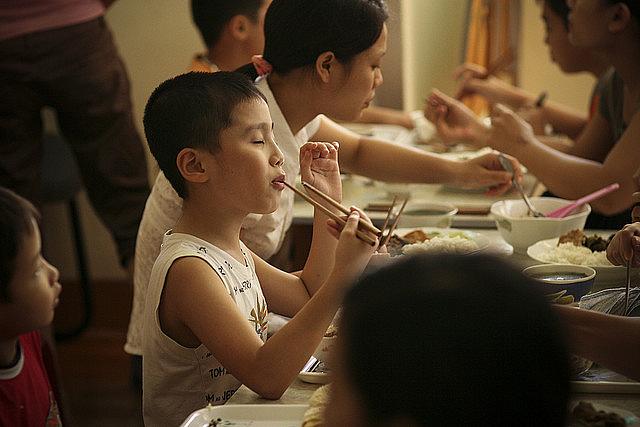In Asian communities, raising a child with autism can be a lonely, difficult road

In Asian families, raising a child with autism spectrum disorder means not only piles of bills, long wait-lists and underfunded programs, but also a life of double isolation.
“We didn’t see anything wrong with Ethan,” Kai-lan, whose 3-year-old son was in the same child day-care center my daughter attends, said to me when she was told that her son was advised to have the autism screening test. “We don’t need to worry about him crying or running around. He is a very good and quiet boy. ”
But the day-care center teacher, Miss Dorothy, voiced the other side of the story. “Ethan doesn’t play with others. He is sitting by the table all day playing whatever people put in his hand. He sometimes reacts to teachers but he doesn’t speak words other than ‘ma-ma’ and ‘na-na’(grandma).”
A week later, after Kai-lan brought her boy to a screening, they disappeared from the day-care center. Miss Dorothy told me that Ethan was confirmed as having early-stage ASD.
I haven’t seen the boy since, but I did once run into Kai-Lan in a “GongSuo” (community center) in Lower Manhattan’s Chinatown. She was there asking for help. Kai-lan apparently didn’t want to talk to me, especially when I asked how Ethan was. She quickly replied: ”He’s good.” Mr. Chow, the senior consultant in the community center, later told me that Kai-lan and her husband found it very difficult to accept that their child has autism and they were afraid of being isolated by the community. Actually, some of their relatives and friends stopped talking to them or started to blame them when they learned about their kid’s situation. Mr. Chow referred Kai-lan to a program offered by Chinese Christian Herald Crusades, a Christian church based in the Chinese community. That is the only available program to them that supports families with autistic children in New York City.
Kai-lan’s story is common in the Chinese community. Children with autism spectrum disorder remains invisible. Parents who have a child with mental health problems often go to see their doctors with guilt and shame, thinking their children’s illness is their own fault. This feeling from the parents actually creates a double isolation for a child on the autism spectrum.
Another factor that causes the double isolation has to do with cultural differences, including language barriers. It would be easier for Kai-lan and her families to find help if they spoke fluent English. According to a study done by the Coalition of Asian American Children and Families, Asian Pacific Americans in New York City have the highest rate of linguistic isolation. Adults in those families depend on family members under 14 to translate for them. It can be really hard for parents to understand and gain information about autism spectrum disorder. On the other hand, due to cultural differences, some of the early signs of autism spectrum disorder, such as delayed speech and lining up toys or other objects, can be interpreted as “being quiet” or “being tidy,” which are characteristics highly valued by Asian parents. Does the current standard of milestone checklists suit Asian children? How do we help Asian parents spot early signs of autism? How to raise awareness of autism in Asian Community, break down the stigma around it, and make sure that such families get enough support?
The 2015 National Health Journalism Fellowship gives me the chance to explore the issue and find answers to these problems.
During my project, I hope to reach out to families raising children on the autism spectrum, learn about their daily life, their worries and their needs. Personal stories with true details can illustrate what the disorder really means to the child, the family members and the people around them, and also raise awareness of autism-related disorders in the Asian Community.
Secondly, I want to explore how cultural differences factor into the diagnosis of autism spectrum disorder, especially in the early phases. Unlike some other diseases, it cannot be diagnosed by a blood test or brain scan; it is diagnosed by a specialist who talks to parents worrying about their kids. I am making a list of experts and doctors that I plan to interview; they are not only specialized in autism spectrum disorder, but also familiar with the Asian community. I would love to hear about their stories in diagnosing and treating the disorder among children of immigrant families.
Besides parents and specialists, early learning facilities and daycare center teachers also play an important role in spotting early signs of autism in children. In some cases, I’ve found they are the first ones to point out the early signs to the parents. The daycare center teachers and early education experts are the third group of people that I plan on interviewing for their perspectives.
Finally, I would love to touch on how the Asian community supports families dealing with autism. Chinese Christian Herald Crusades runs the Autism Family Support Program, in which volunteers provide childcare to diagnosed children. Korean Community Service of Metropolitan New York, the first community-based social service agency targeting the Korean population, launched an autism hotline in July 2014. I plan to connect with these organizations and learn about how the programs are working.
But based on my research, I’ve found there are very few options for the Asian families seeking help when it comes to autism spectrum disorder in their own community (in the same language, with the same cultural background). Hopefully this project can shed some light on the weakest links in community support and point to potential improvements down the road.
[Photo by AngelsWings via Flickr.]

